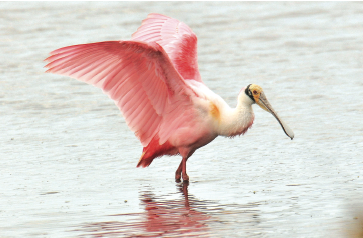MICHAEL GIVANT
Contributing Columnist
givant@lbknews.com
Durante Park is one of Longboat Key’s better avian seafood cafeterias, and this morning it’s brimming with patrons. Perched in a tall bare tree that it shares with a large number of starlings is an osprey. In a manacled claw, the raptor holds a long headless silver fish as if it were a sub sandwich with a tail. The tree limb however offers no flat surface for the osprey’s meal. More than once it almost drops the fish, but each time the raptor flaps its wings and secures a grip with its talons. The bird, which has a blazing yellow eye, looks around nervously.
Wood storks are occasional diners here. Today four are feeding in shallow water by a footbridge. These birds, nearly three-and-a-half feet in length, are on the endangered species list. The bird’s black and dull white bill is long and down curved. One sticks its knobby black and white head in the water up to the base of its neck and beyond. That rugged looking head is the reason the bird is sometimes called “Gourdhead“ or “Ironhead.” Raising its head from the water, the bird’s neck feathers are soaked from being submerged. The bird is as sharp and clear as HDTV.
The wood stork hunts with its bill partially open until it touches prey and snaps it shut. This is called “grope-feeding.” The bill closes in one-fortieth of a second, giving prey little if any chance to escape. One wood stork comes up with something glistening in its bill. With a slightly bulging, coal black eye, the stork walks calmly to another spot. It’s long gray legs have a dark pink joint at the back of where they bend, and the long feet are the same color. The water, which is brown, oddly appears to have a reddish brown area when the bird is fishing. Looking closely, it is the bird’s dark pink foot that is apparently being used to “stir the pot” and raise up small fish.
Two mornings later there are 15 wood storks feeding in the same spot. One has a small wriggling silver fish in the tip of its bill. I’ve never seen this number of wood storks before. There are also two roseate spoonbills feeding with them. In the bright morning sun, these birds that are on the species of special concern list are riveting with their colors seeming to splash out at the viewer. The spoonbills are white with a dark and light pink on the sides, some yellow near the wing joint, an orange tail and a small bulging red eye. Their heads also seem to have a light green hue. Their flat, stone gray bills resemble wooden Dixie Cup spoons and give them an otherworldly look. They are the birds from Mars.
I’ve seen them here only once before, several years ago. They flew as I approached them on one of the park’s wooden footbridges, and I haven’t seen any here since. Now walking in the water, they repeatedly sweep their bills side to side searching for small fish and aquatic invertebrates. When prey is located, the bill shoots toward the sky appearing to be swallowing. But what? Another is so close to me, I can see its orange tail and red legs without my binoculars. I cannot believe my luck!
Just then an osprey flies to a tree with what looks like a fish. I want to see the raptor start its meal, but I can’t take my eyes off the scene in front of me. When will I ever see 15 wood storks and two spoonbills feeding side by side again?
There’s a lone great egret among this mass to which I’ve ignored until now. It’s been still, but now holds a small, dark wriggling fish in the tip of its long yellow bill. The egret downs the fish, chewing side to side with relish. It’s a measly meal but a triumph in this crowded spot!
The next morning walking through the park, there’s the briny small of low tide. In the pale water of Sarasota Bay a lone white pelican is slowly cruising, leaving a dark blue line behind it. A Louisiana heron walking in the water bends down to the water, its neck crooked and eats something. With its yellow bill thrust out and neck still crooked, the bird moves quickly through the shallow water looking for more breakfast.
A lone great egret, with the patience of a Job, stands in the eerily white water that reflects the clouds above. Soon it has a wriggling silver fish crosswise in its bill. The fish slowly stops struggling and the egret moves it back, back, back in its bill, and a slow moving bulge begins in the bird’s throat. Now the bird, its face inches from the water’s surface looks patiently, standing completely still.
A belted kingfisher stands on a piling not doing much. Looking around, the morning rush seems to be over. On the way out of the park there’s a wood stork in a tree. It may roost near here in some mangroves. I watch it for a while until the bird looks at me looking at it. Birds don’t like being looked at directly, and not wanting to scare it off I put down my binoculars and walk away. Tomorrow I’d like to see it here gulping down the catch of the day.

